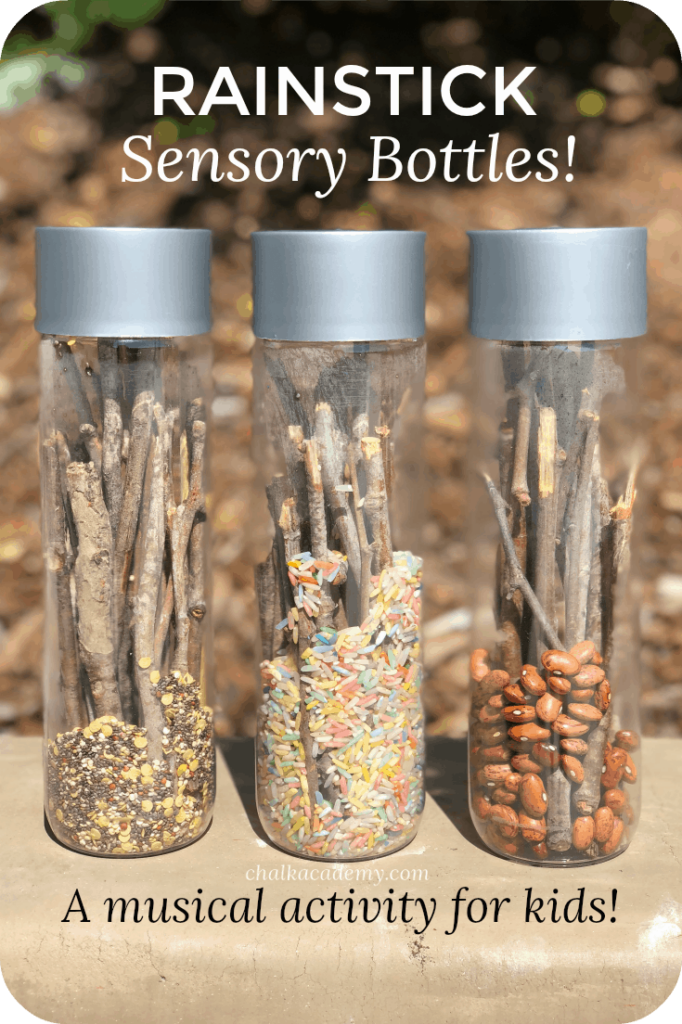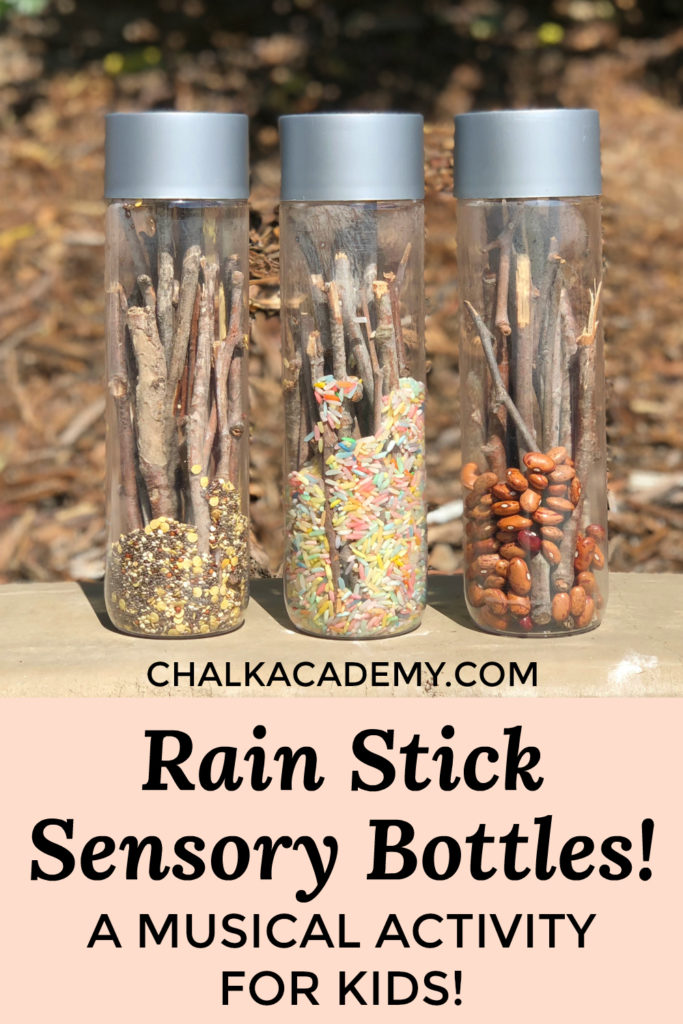How to Make a Rainstick Musical Sensory Craft for Kids! (VIDEO)

Rainstick sensory bottles are fun and easy to make with children of all ages! My kindergarten daughter and I enjoyed coming up with musical “ingredients” together. In addition, she and her toddler brother enjoyed the tactile, auditory, and visual entertainment from touching, shaking, and watching the homemade rainsticks in action!
I’ll show you how we made this, and you can hear how they sound in the video at the end of the post!
Wishing for sounds of rain
For the past week, my children and I have been reading books about rain and working on learning activities about rain.
Although rainfall has been low in California due to the drought, my children get so excited about the few rainy days of the year.
My daughter talked about a big rainstorm from a few weeks ago as if it had just happened! She and her brother loved wearing their rain jackets and rain boots and jumping in puddles.
In addition, they loved to sit by the window and watch and listen to the raindrops tap dance on our windows. Therefore, these rainstick sensory bottles were a big hit for exploring different “pitter-patter” sounds.

Chalk Academy is reader-supported. Some of the links are affiliate links. When you buy something through an affiliate link, we may earn a very small commission at no additional cost to you. More details here.
Cultural significance of rainsticks
Water has long been a reason to celebrate. During periods of drought, many cultures have ceremonies to pray for rain.
Indigenous people of Latin America would dry a cactus and smooth it of its needles. Then, they filled the hollow cactus with beans or pebbles and sealed the ends. Ceremonies would then take place with the rainsticks, trying to usher in rain to a dry climate. Many Native American tribes would have rain dances to accompany their rainsticks.
Now, they’re used as percussion instruments to mimic the sound of rain. Even foley artists use them for audio for movies! They’ve also become a go-to sensory activity for kids, like our children’s homemade rainstick.
How to use your homemade rainstick
The sound of rain has also been known to be very soothing for adults and children. You can use the homemade rainstick as a calming activity to help your child relax and wind down. Sensory bottles have long been a beneficial tool for when emotions get too overwhelming.
Adults use them for meditation, and kids can use them as a mindfulness activity. Having kids focus on the movement and sound of the jar can boost their overall concentration.
Children can also use the rainstick to learn about cause and effect. When they move it a certain way, they get a lovely rain sound.
It can help with fine motor skills as well. For example, occupational therapy sessions have used sensory bottles to help with strength, coordination, and range of motion for the fingers and arms.
In my home, I use them as an opportunity to teach our children to speak a minority language. Just like speech therapy classes, a homemade rainstick can be used to encourage describing sounds, textures, colors, and even core vocabulary like stop and move.
Bilingual vocabulary about rainsticks
Since my children and I are learning Chinese together, I like to take notes on new vocabulary related to activities that we are creating. Here is a list of words that describe rain sounds in simplified Chinese, traditional Chinese, Pinyin, and English!
- 雨 (Yǔ / rain)
- 雨滴 (Yǔdī / raindrop)
- 敲 (Qiāo / knock)
- 落 (Luò / fall)
- 声音 / 聲音 (Shēngyīn / sound)
- 噼里啪啦 / 劈裡啪啦 (Pīlǐpālā / crackling sound)
- 滴答 (Dīdā / tapping sound)
- 簌 (Sù / rustling sound)
Here are some Chinese phrases and sentences that we practiced with our DIY rainsticks:
- 让我们做一个雨棍。/ 讓我們做一個雨棍。(Ràng wǒmen zuò yīgè yǔ gùn. / Let’s make a rainstick.)
- 把它翻过来。/ 把它翻過來。(Bǎ tā fān guòlái. / Turn it over.)
- 它听起来像什么? / 它聽起來像什麼?(Tā tīng qǐlái xiàng shénme? / What does it sound like?)
Related: Water Painting Chalk Raindrops – Sight Word Activity

Music rainstick sensory bottle inspiration
One of my earliest memories of elementary school music class involved making rainsticks with upcycled cardboard rolls. When I was brainstorming ways to create the rainstick bottle, I saw these musical rainstick sensory bottles on Rhythms of Play. Instead of cardboard rolls, the teacher used recycled clear water bottles.
I instantly knew my children would love seeing action through the transparent water bottle!
Related: Educational Activities Made from Recycled Materials!
What you need to make a homemade rainstick sensory bottle
- Voss water bottles – these pretty bottles have labels that peel off easily compared to other bottles!
- Branches
- Rice, beans (eg, pinto, garbanzo, lentil), seeds, sprinkles, sand, salt, sugar, pebbles, etc.
- Tray (ours are similar to this)
- Bowls
- Scoops
- Funnel
Optional: Adhesive remover – there was very little sticky residue on our bottles, so we skipped this step. However, for other plastic bottles with sticky residue, the adhesive remover can be very helpful.
How to make a rainstick sensory bottle
- Remove labels from bottle; wash and dry bottle
- Set up everything in the tray
- Insert branches
- Scoop and pour desired elements
- Close lid tightly
- Let your child explore!
Related: Favorite Nature Learning Activities for Kids!

Thoughts on avoiding food waste when making rainstick bottles
Our favorite musical sound is the bottle with the bell pepper/chia seed mix. This seed mix was leftover from a Chinese activity about 子 from last year.
The rice and beans were expired, and these are items that we store in our sensory bin drawer. I do not want to encourage food waste, so please do not buy large bags of rice and beans just for this activity.
Instead, see what you have at home! Before throwing out expired food, think about what can be repurposed for educational play!
I have seen other parents and teachers use plastic straws in their rainstick bottles. However, I kindly suggest using natural elements and minimizing plastic whenever possible.
Our kids can have fun learning while being mindful of our environment!
Video of musical rainstick sensory bottles
The joy of rainsticks all lies in the sound. It’s pretty well the closest thing we can get to the real thing! Check out the sound of the rainsticks and how different materials can slightly change the noise the rainsticks make.
Have you tried making rainstick sensory bottles with your child?
If you loved learning how to make a rainstick, please let us know in the comments! We’d love to know what your family or school thought of this activity!
More nature activities for children
- Bottle Cap Raindrops Word-Matching Fine Motor Activity
- It’s Raining Paint!
- Learning About 雨滴 with Raindrop Stickers
- Parts of a Flower Sensory Bottles

I loved this..sensory bottles in a different way.
I LOVE this! Putting the sticks inside with the other materials is brilliant, had not thought about that before.
Thank you so much, Kelly! I hope your family can enjoy the activity! I hope you can try some of our other sensory bottle ideas, too! 🙂